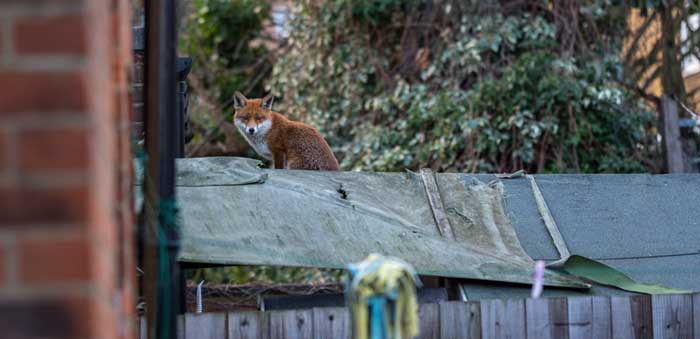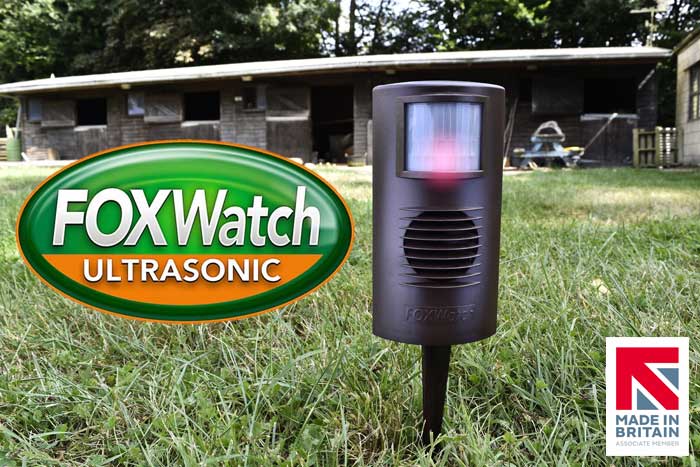“I have a fairly small garden and a family of six foxes have just taken residence. I want to get a deterrent but I have two cats and many of the deterrents seem to affect cats as well. Can you please advise which is the best option in these circumstances?”
– Abigail.
This message from Abigail, worrying about inadvertently scaring her cats while trying to deter foxes, is a very common concern.
As any cat owner will testify, if you’ve upset your cat in some way, they definitely let you about know it. Disappearing for the day, sulking under the bed or sitting facing the wall with their back to you are typical signs that you’ve incurred the wrath of your cat.
So, we want to protect our gardens from foxes, but how can we ensure that our cats aren’t inconvenienced at the same time?

Fox deterrents don’t harm cats or foxes
A word that people often use in relation to their cats and fox repellents is ‘harm’.
For example: “I’m not sure about that fox repellent. I don’t want to harm my cat trying to get rid of the fox.”
It’s a completely reasonable thing to say. Of course you don’t want to accidentally harm your cat in your attempts to keep foxes away.
However, it’s very important to understand that fox deterrents don’t cause harm to any animals, not even to foxes themselves. Fox deterrents sold legally in the UK are generally very humane and don’t make foxes stay away by causing pain or suffering.
In fact, the purpose of a good quality fox deterrent is to change the fox’s attitude to your garden from somewhere that it has free reign to do as it pleases to an environment full of uncertainty, doubt and potential danger.
Foxes don’t hang around for long in areas they feel unsafe and that’s what the most effective fox repellents capitalise on.
It’s all about territory
The biggest difference between wild foxes and domestic cats is the importance placed on territory.
A typical day in the life of a fox is dominated by scent-marking its territory (pooing and urinating) and generally doing the rounds ensuring rival foxes are not trying to take over.
Of course, cats have their squabbles with neighbouring cats, which can be upsetting to owners who feel their cat is getting bullied. However, in the grand scheme of things, the battle for territory is not a life and death situation for a cat like it is with a fox.
A domestic cat knows their owner will feed it and it knows it can always run inside to the safety of the house if things get awkward.
On the other hand, a wild fox is completely reliant upon itself. It doesn’t have the luxury of a waiting bowl of food or a nice comfortable sofa to retreat to. One wrong move and the fox could potentially lose its life.
This makes foxes incredibly risk averse. If they get a sniff of potential danger, they will get out of the area and won’t stick around to risk injury or death. Their survival literally depends on it.
You’ll see below that the recommended fox deterrents are targeting the fox’s sense of territory, they are not doing anything that will impact upon your cat.

Your cat’s biggest problem is the fox itself
While you’ve been thinking about what effect a fox repellent might or might not have on your cat, you may have actually overlooked the thing that is upsetting your cat the most…
The fox itself!
The smell, the sight and the sound of the fox is going to be far more stressful for your cat than any deterrent you use to get rid of it.
Some common symptoms of a stressed cat include:
- A reluctance to go outside
- A reluctance to use the cat flap
- Going to the toilet inside
- Going outside, but nervously
- Not venturing far from the house
- Staying low and cautiously sniffing the ground outside
- Generally not being ‘themselves’
If you have foxes regularly coming into your garden and your cat displays some of the characteristics above, then you can be pretty sure that they’re feeling some degree of fox-related stress.
The sooner you take action and reduce fox visits to your garden, the sooner your cat is going to brighten up and feel happier about going outside.
So what are the best cat-friendly fox deterrents to use in your garden?
The FoxWatch Ultrasonic Deterrent

The FoxWatch is a very simple little device that lets out high-pitched blasts of ultrasonic noise each time a fox crosses the motion sensor.
The noise acts as both a surprise and an irritation to the fox, causing it to associate your garden with potential danger and that all-important disturbance to its territory, as discussed earlier.
Within a short space of time, the fox visits to your garden will reduce until the fox begins to completely avoid your garden, dropping it from its territory altogether.
• Read more about The FoxWatch Ultrasonic Fox Deterrent
Now, it’s important to note that although the sound of the FoxWatch is within the hearing range of cats, the frequency is bothersome to foxes rather than cats. Your cat won’t be cowering behind the sofa because of the FoxWatch.
In fact, a high percentage of FoxWatch owners also have cats and use the unit highly successfully to deter foxes without upsetting their cats.
Many people report that, once the FoxWatch has been installed and is successfully keeping foxes away, their cats become much more relaxed about leaving the house.
“The fact that I can put it out into the garden and forget about it is great. The FoxWatch has kept my back garden clear of foxes for nearly a year now.”
– Mr Longman, Croydon
The best place to put the FoxWatch is facing the point that the FoxWatch gains entry to your garden. This means that the fox will trigger the FoxWatch as soon as it attempts to enter your garden, rather than being allowed to come in further before encountering a deterrent.
The quicker the fox faces a deterrent as it enters your garden, the quicker it will learn to be wary and stay away.
The FoxWatch is durable, safe and humane for all animals and is something you can set and forget without ongoing attention or maintenance. As foxes are especially persistent, the FoxWatch acts as a good automatic deterrent that can be left on all the time (with mains adapter or battery), deterring foxes regardless of the time of day or if you’re in or out.
The FoxWatch is available in our store priced £69.95. All FoxWatch units come with 12 Volt Mains Adapter, mounting stake, full set-up instructions, free UK delivery, 90 money back guarantee and 2 year manufacturer’s warranty.
Scoot Fox Repellent

Scoot is a scented fox repellent that works slightly differently to how you might expect.
Many scented deterrents contain citronella, which most animals (including foxes and cats) are physically repelled by, hence reader Abigail’s concern that all fox repellents also seem to affect cats.
However, Scoot doesn’t contain citronella and doesn’t seek to repel foxes by creating a smell so bad that the fox (or your cat) doesn’t want to go near it. It’s actually cleverer than that and again targets the fox’s sense of territory.
The scent of Scoot mimics that of another predator, tricking the fox into thinking a rival fox has taken over the territory so that it keeps away from your garden.
Scoot is humane and biodegradable so it doesn’t harm your garden and won’t be of concern to your cat. It’s simply a powder you mix with water and is very fox-specific due to the nature of the smell.
• Read more about Scoot Fox Repellent
The main downside for some people is that Scoot is higher maintenance than the FoxWatch, requiring you to be out in your garden every couple of days for around two weeks spraying the solution. While this seems a bit more hands on, it ensures the scent remains strong and consistent enough to be of concern to the fox.
It’s easy to make the mistake of spraying Scoot once and considering it to be job done. However, once is not enough and is actually one of the main reasons for some negative reviews floating around the Internet about Scoot. You need to spray it multiple times over a sustained period, which many people either don’t realise or aren’t prepared to do.
Foxes are persistent and, once they smell this new scent, they will be back again to see if it’s still there. Allow the scent to weaken and the fox will consider it a mild inconvenience. Keeping up the potency by regularly spraying will convince the fox that the rival has taken over and it should give up your garden.
If you use it properly and don’t mind the extra effort, Scoot can be a very effective fox repellent. If a fox comes back again in the future, simply get some more and repeat the process.
Doing your cat a favour

In conclusion, if you have foxes coming into your garden and are worried about the impact it’s having on your cat, it’s important you take steps now and use a fox deterrent in your garden.
While it’s very unlikely that a fox will actually attack a cat, as we discussed above, the psychological impact possibly being suffered by your cat is much more of a reality.
Hopefully this article has demonstrated that using a fox repellent is not going to upset your cat.
Instead, you should be feeling more confident that you’re actually helping the situation. Claiming back your garden from the fox is likely to make your cat much happier inside and outside your home.
You might also be interested in…
• The FoxWatch Ultrasonic Fox Deterrent – Made in Britain
• How Scoot Fox Repellent can trick foxes into staying away
• The UK’s Top 10 Fox Repellents






 I’ve recently had a few people contact me regarding foxes causing damage to their cars.
I’ve recently had a few people contact me regarding foxes causing damage to their cars.








